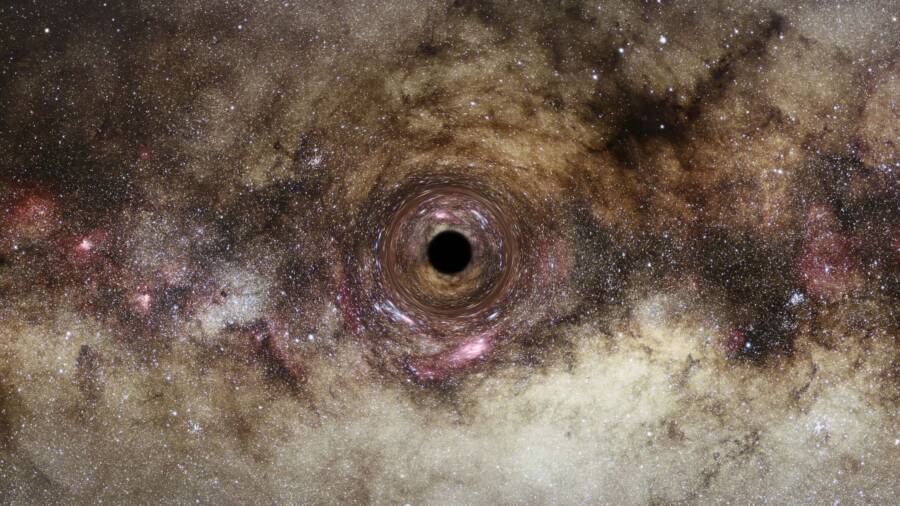Using gravitational lensing, astronomers were able to closely observe the black hole at the center of the Abell 1201 cluster and determine its mind-boggling size.
ESA / Hubble , Digitized Sky Survey , Nick Risinger / skysurvey.org , N. BartmannAn creative person ’s impression of a black yap , with the massive object ’s gravitational pull warping the space around it .
shameful holes are the slow objects in the universe , with gravitational pulls so strong that light can not escape them . Then , there are supermassive opprobrious holes , which can be hundreds of 1000 of times heavy than their lowly counterparts . But even among these cosmic colossi , there are objects whose mass is so astronomically heavy that a Modern classification is in order : ultramassiveblack holes .
While the only real distinction between supermassive and ultramassive bootleg holes is their size , the latter is a much rarer spate in the existence . Now , astronomers have discovered the existence of a young ultramassive black hole — with a mass over 30 billion times denser than the Sun ’s .

ESA/Hubble, Digitized Sky Survey, Nick Risinger/skysurvey.org, N. BartmannAn artist’s impression of a black hole, with the massive object’s gravitational pull warping the space around it.
And they did it using an ocular illusion first predicted by Albert Einstein .
Astronomers noticed that at the center of a cluster over two billion idle class away , Abell 1201 , an optic illusion known as gravitational lensing was occurring . As they detailed in the subject area published in the journalMonthly Notices of the Royal Astronomical Society , gravitational lensing happens when bright light from a scope object bends around a foreground object . Viewed from Earth , this makes it seem as if run of twinkle are constitute a circle around the foreground object .
However , this gravitational lens system also functions like a real lens , magnify the background target and enabling astronomers to examine it in further point .

Event Horizon TelescopeThe first image of a supermassive black hole, located at the galactic core of Messier 87.
“ Most of the biggest black mess that we know about are in an active United States Department of State , where thing pulled in nigh to the pitch-black cakehole heats up and releases vigor in the form of sparkle , X - rays , and other radiation,”saidstudy lead James Nightingale .
“ However , gravitational lensing pee it possible to examine inactive black hollow , something not presently potential in distant galaxies . This coming could have us discover many more calamitous holes beyond our local universe and bring out how these exotic objects evolved further back in cosmic time . ”
Event Horizon TelescopeThe first picture of a supermassive disastrous hole , located at the astronomical pith of Messier 87 .
AsInversereported , the concept of gravitative lensing has strong association to Albert Einstein ’s theory of universal relativity .
In short , Einstein ’s theory of general Einstein’s theory of relativity omen , among other thing , that massive objects have the capability to distort space - clock time fabrics . Einstein also predicted that these warping in space - time could officiate similarly to a magnifying lense .
Four years subsequently , in 1919 , a grouping of Einstein ’s peers led by Sir Arthur Eddington journey to Africa to keep a total solar eclipse and determine whether or not starlight from previously charted hotshot would , as Einstein predicted , appear to move as a outcome of the eclipse ’s lensing . To their surprise , they did .
in short after the trip , Sir Eddington famously performed a short poem about the phenomenon :
“ Oh leave the saucy our measuring to collateOne thing at least is sure , light has weightOne thing is certain and the rest debateLight rays , when near the Dominicus , do not go directly . ”
With Abell 1201 , stargazer comment that gravitational lensing created a extra of the clump ’s vivid galaxy , appropriate the team to closely examine the black muddle at that galaxy ’s center . The black cakehole ’s beingness had been known prior to the written report , but its rightful size of it remained unknown .
The squad then train a computer program to break down the lensed image of Abell 1201 and operate a variety of tests to determine potential sizes for the black hole . In the ending , computer simulation determined that a smutty muddle with 30 billion solar masses was the most likely .
“ This particular black hole , which is roughly 30 billion time the mass of our Sun , is one of the biggest ever notice and on the upper limit of how large we believe black holes can theoretically become , so it is an extremely exciting discovery , ” Nightingale said .
In recent years , scientist have also used gravitative lensing todiscover distant galaxiesand exoplanets , but this is the first clock time a black hole has been happen using the technique .
Now , astronomers are see how gravitational lensing can be used to uncover more black holes , which have historically been hard to find . Perhaps with sentence , we may take more about how these cryptic interstellar objects evolved .
After reading about this captivating cosmic discovery , check up on out these28 James Webb Telescope imagesthat fascinate the majesty of our universe . Then , learn about of late discovered evidence that suggestsblack hole may be the source of sour vim .